McAllen Overland 4×4 accessories offer high-quality recovery lines crucial for off-road safety. These durable materials enable effective rescue in challenging terrains like mountains or mud. Different types of recovery lines, such as winch straps, tow ropes, cam buckle lines, and ratchet straps, cater to various recovery needs. Choosing the right material—synthetic for durability or nylon for strength-to-weight ratio—ensures reliable performance based on vehicle type and intended use.
Recovery lines are indispensable McAllen-Overland 4×4 accessories for off-road adventures. This article explores their purpose and significance in navigating challenging terrains. We’ll guide you through different types of recovery lines, from synthetic to nylon materials, offering varied strengths and lengths. Installation, real-world applications, and maintenance tips will equip you with the knowledge needed for secure and effective towing. Learn how to maximize your McAllen-Overland kit’s potential while ensuring safe operations during every journey.
- Understanding Recovery Lines: Essential Equipment for Off-Road Adventures
- – Definition and purpose of recovery lines.
- – Importance in McAllen-Overland 4×4 accessories.
- Types of Recovery Lines: A Comprehensive Guide
- – Different materials used (e.g., synthetic, nylon) and their benefits.
Understanding Recovery Lines: Essential Equipment for Off-Road Adventures

Recovery lines are an indispensable tool for off-road enthusiasts and overlanders alike. These robust cables or chains serve as a safety net, allowing you to tow and extract your vehicle from challenging terrains. When faced with a flat tire, a stuck wheel, or even a complete breakdown, having reliable recovery lines can make all the difference in your adventure’s outcome.
McAllen Overland 4×4 accessories offer a wide range of recovery line options tailored for various driving conditions and vehicle types. Whether you’re traversing rugged mountains or navigating through deep mud, a well-equipped set of recovery lines ensures peace of mind. Choose from high-quality materials designed to withstand extreme stress, offering the strength and durability needed for off-road rescue.
– Definition and purpose of recovery lines.

Recovery lines are specialized vehicles designed for off-road adventures and emergency situations, equipped with essential mCallen-Overland 4×4 accessories. Their primary purpose is to ensure safe and efficient extraction or rescue in rugged terrain where conventional vehicles might struggle. These lines, often made from high-strength materials, allow rescuers or adventurers to pull themselves or their equipment out of challenging positions, such as deep mud, sand dunes, or rocky inclines. With the right set of recovery line accessories, 4×4 enthusiasts can face even the most demanding off-road challenges with increased confidence and peace of mind.
– Importance in McAllen-Overland 4×4 accessories.

Recovery lines are a vital component in McAllen-Overland 4×4 accessories, offering unparalleled performance and reliability when navigating challenging terrains. These robust lines are designed to withstand extreme conditions, ensuring your vehicle’s towing and recovery capabilities remain unmatched. With high-quality construction and durable materials, they provide a secure connection between your rig and the recovery vehicle, giving you peace of mind during off-road adventures.
In the demanding landscape of McAllen-Overland 4×4 accessories, where durability and performance are key, recovery lines play a pivotal role. They enable drivers to confidently tackle tough trails, knowing their vehicles are equipped with the best support systems. These essential accessories are a game-changer for folks who love to explore remote areas, ensuring they can return safely and swiftly.
Types of Recovery Lines: A Comprehensive Guide

When considering McAllen-Overland 4×4-accessories for your vehicle, understanding the diverse types of recovery lines is essential. These lines serve as critical components during off-road adventures or unexpected roadside situations, providing the necessary tools to extract or stabilize your vehicle.
There are several types of recovery lines available in the market, each designed for specific purposes. For instance, winch straps are versatile and suitable for a wide range of recovery scenarios, from towing vehicles out of soft terrain to lifting heavy objects. On the other hand, tow ropes are ideal for lighter vehicles and offer a simple solution for short-distance recoveries. Additionally, cam buckle lines stand out due to their ease of use and adjustability, making them perfect for dynamic rescue operations. Meanwhile, ratchet straps excel in securing heavy loads and distributing weight evenly, ensuring safer recoveries.
– Different materials used (e.g., synthetic, nylon) and their benefits.

When choosing recovery lines for your McAllen-Overland 4×4 accessories, selecting the right material is key. Synthetic lines offer superior durability and resistance to abrasions, making them ideal for challenging off-road conditions. Their flexible nature ensures smooth operation during recovery maneuvers. Nylon, another popular choice, boasts exceptional strength-to-weight ratio, providing both reliability and ease of handling. It’s known for its resistance to stretching, a feature crucial for precise and safe recoveries.
Each material has unique benefits that cater to specific needs. Synthetic lines’ high tear strength makes them suitable for demanding rescue situations while nylon’s smooth texture reduces the risk of line damage during deployment. The selection should align with your vehicle type, intended use, and the nature of recovery operations you frequently undertake.
Recovery lines are an indispensable component for any off-road enthusiast. With their versatile applications, these McAllen-Overland 4×4 accessories ensure you’re prepared for various terrains and challenges. By understanding the different types and materials available, you can choose the perfect recovery line to enhance your next adventure. Whether navigating rough landscapes or tackling difficult obstacles, having the right equipment makes all the difference.



